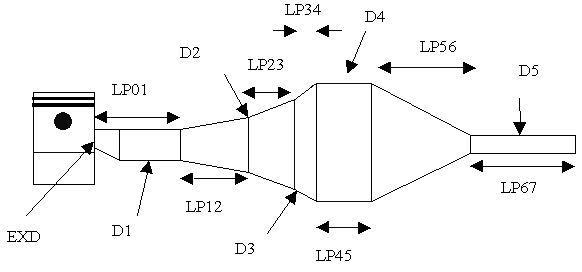
 Description:
Description:The expansion chamber design software is used to design the tuned pipe for the exhaust system of the micro-car engine. One can choose to design a single-stage, two-stage or three-stage diffuser chamber according to their requirements. This section details the various parameters and design formulae, which have been implemented in the software design project.
Attaches to the engine and is the straight or slightly divergent (opens up 2-3 degrees) section of the pipe. It helps to suck the exhaust gases out of the engine. The header pipe cross-sectional area should be 10-15% greater than the exhaust port window for when maximum output at maximum RPM's is desired. In some cases, the area of the header pipe may have a cross-sectional area of 150% of the exhaust port area. The length should be 6-8 of its diameter for maximum horsepower, for a broader power curve 11 times the pipe diameter may be used. The part you trim off to tune.
The section of the pipe that attaches to the header and opens up at an angle like a megaphone. It intensifies and lengthens the returning sound waves thus broadening the power curve. The steeper the angle the more intense the negative wave returns, but also the shorter the duration.
The lesser the angle, of course, returns a less intense wave, but for a longer period of time (duration). The outlet area should be 6.25 times the inlet area. 7-10 degree taper angle.
Located between the divergent and convergent cones, its length determines the relative timing of the negative and positive waves. The shorter the belly the shorter the distance positive waves travel and the narrower the RPM range. This is good for operating at HIGH RPM only.
The longer the belly the broader the RPM range. The diameter of the belly has little or no effect.
Located after the belly and before the stinger, reflects the positive waves back to the open exhaust port and forces the fresh fuel mixture back into the combustion chamber as the exhaust port closes. The steeper the angle the more intense the positive wave and the gentler the angle the less intense. 14-20 degree taper angle. The taper angle primarily influences the shape of the power curve past the point at which maximum power is obtained.
Located at the opposite end of the pipe from the header and after the convergent cone, it is the "pressure relief valve" of the pipe where the exhaust gasses eventually leave the pipe. The back pressure in the pipe is caused by the size (diameter) or length of the stinger. A smaller stinger causes more back pressure and thus a denser medium for the sound waves to travel in. Sound waves love denser mediums and thus travel better. A drawback to a small stinger is heat build-up in the pipe and engine. The stinger diameter should be 0.58–0.62 times that of the header pipe and a length equal to 12 of its own diameters.
When the engine fires it detonates the fuel mixture in the combustion chamber, pushes the piston down, opens the exhaust port, and allows the burnt gases to escape along with the sound wave produced when the engine fired. The negative sound waves pull the exhaust gasses out of the exhaust port. The positive sound waves, reflected back from the convergent (baffle) cone, force the fresh fuel mixture back into the combustion chamber through the exhaust port thus supercharging your engine.
| BMEP_bar | Avg. Exhaust Temp. |
|---|---|
| 11+ | 650 |
| 8-10 | 500-600 |
| 5-7 | 350 |
Where g is the specific heat ratio of air i.e. 1.4.
R is the Gas Constant of air i.e. 287.
Texc is exhaust gas temperature.
The values for k1 and k2 are ranges depending on the type of engine. k1 ranges from 1.05 to 1.125 while k2 ranges from 2.125 to 3.25. Finally the tuned length:
Where qep is exhaust port open duration in degrees.

Where Lt is tuned length.
Eo is an exhaust-open period.
Vs is sonic wave speed.
N is crankshaft speed.
D1 is 10 to 15% greater than the exhaust port window.
A1 = (half the diffuser's angle of divergence).
A2 = (half the baffle-cone's angle of divergence).


Notice also that an extra coefficient has been introduced. This coefficient Kh is called the horn coefficient, with typical values between one and two. Small values of Kh are best suited to Grand Prix engines with narrow power bands, larger values are for wider more flexible engines.
Download several useful manual files in PDF format for many two-stroke engines/models.
Consider buying me a coffee if you enjoy the content shared with you.
© Copyrights by RD350.info | Torque-Induction. All rights reserved.